There are many different surgical specialties, some of which require very specific kinds of surgical instruments to perform.
General surgery is a specialty focused on the abdominal contents, as well as the thyroid gland, and diseases involving skin, breasts, various soft tissues, trauma, peripheral vascular disease, hernias, and endoscopic procedures.
This page is dedicated specifically to listing surgical instruments used in general surgery.
Instruments can be classified in many ways - but broadly speaking, there are five kinds of instruments.
- Cutting and dissecting instruments:
- Scalpels, scissors, and saws are the most traditional.
- Elevators can be both cutting and lifting/retracting.
- Although the term dissection is broad, energy devices such as diathermy/cautery are often used as more modern alternatives.
- Grasping or holding instruments:
- Classically this included forceps and clamps predominantly.
- Roughly, forceps can be divided into traumatic (tissue crushing) and atraumatic (tissue preserving, such as Debakey's)
- Numerous examples are available for different purposes by field.
- Hemostatic instruments:
- This includes instruments utilized for the cessation of bleeding.
- Artery forceps are a classic example in which bleeding is halted by direct clamping of a vessel.
- Sutures are often used, aided by a needle holder.
- Cautery and related instruments are used with increasing frequency in high resource countries.
- Retractors:
- Surgery is often considered to be largely about exposure.
- A multitude of retractors exist to aid in exposing the body's cavities accessed during surgery.
- These can broadly be handheld (often by a junior assistant) or self-retaining.
- Elevators can be both cutting and lifting/retracting.
- Tissue unifying instruments and materials:
- This would include instruments that aid in tissue unification (such as needle holders or staple applicators)
- And the materials themselves
Instruments used in surgery are:[1][2][3][4][5][6][7][8][9][10][11]
| Instrument Name | Image | Brief description | Specific instruments |
|---|---|---|---|
| Electrical cautery |  |
Electrical surgical cauterization utilizes electricity in either a mono-polar or bi-polar format to burn soft tissue and control bleeding.[12] |
|
| Curette | 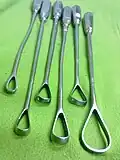 |
for scraping or debriding biological tissue or debris in a biopsy, excision, or cleaning procedure | Come in various sizes and shapes |
| Dermatome | 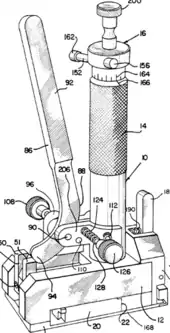 |
To take off a top layer of skin to implant over another area; | |
| Forceps, Dissecting |  |
Grasping/holding. Usually used in skin closure or small wounds | Adson |
| Forceps, Tissue |  |
Grasping/holding tissue | Allis |
| Penetrating towel clamp | 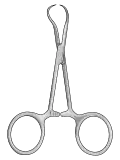 |
Used to secure towels or reduce bone fragments | Backhaus penetating towel clamp |
| Carmalt forceps | haemostatic forceps | kalabasa | |
| Cushing forceps | grasping/holding | Non-toothed dissecting forceps | |
| Dandy forceps | haemostatic forceps | ||
| DeBakey forceps |  |
grasping/holding | Non-toothed dissecting forceps designed for use on blood vessels, organs, or delicate tissue |
| Doyen intestinal clamp | clamps and distractors | Non-crushing clamp designed for use on the intestines | |
| Kelly forceps |  |
hemostatic forceps | |
| Kocher forceps |  |
hemostatic forceps | |
| Mosquito forceps |  |
hemostatic forceps | |
| Hook | retractor | ||
| Nerve hook | retractor | ||
| Skin hook | retractor | ||
| Lancet (scalpel) | 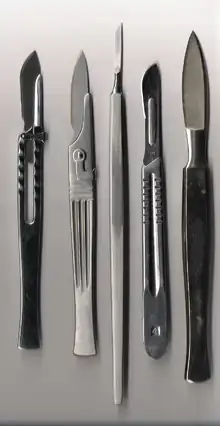 |
cutting | |
| Mammotome | 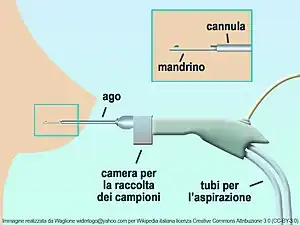 |
||
| Needle holder |  |
grasping/holding | Castroviejo Crilewood Mayo-Hegar Olsen-Hegar |
| Retractor | 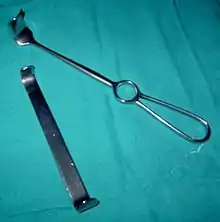 |
retractor | Handheld:
Self-retaining:
|
| Ultrasonic scalpel | cutting | ||
| Laser scalpel | 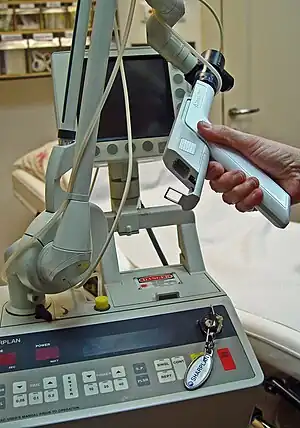 |
cutting | |
| Scissors | 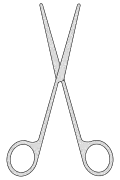 |
Cutting, spreading | May be curved or straight |
| Speculum | 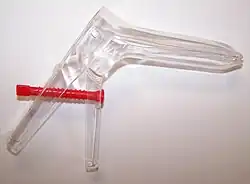 |
Used to retract orifices. |
|
| Suction tube and Yankeur suction tip | 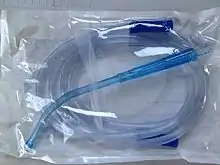 |
accessories and implants | |
| Surgical elevator |  |
||
| Surgical hook |  |
retractor | |
| Surgical blade #15 |  |
Used to cut vessels or make small incisions | |
| Surgical mesh | 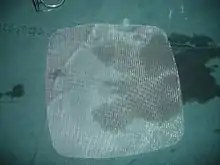 |
accessories and implants | |
| Surgical needle |  |
accessories and implants | |
| Surgical sponge | |||
| GIA stapler |  |
Used to make a gastrointestinal anastamosis | Linear stapler |
| Surgical tray | |||
| Suture |  |
||
| Tongue depressor |  |
||
| Tonsillotome | |||
| Towel clamp |  |
clamp | |
| Towel forceps | clamp | ||
| Backhaus towel forceps |  |
||
| Lorna towel clamp | Non-penatrating towel clamp | ||
| Tracheotome | |||
| Tissue expander | accessories and implant | ||
| Subcutaneous inflatable balloon expander | accessories and implants | ||
| Trephine | 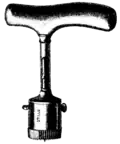 |
cutting instrument | |
| Trocar |  |
Access instrument. Used to create an opening into a space without opening the abdominal cavity. A camera then inserted through one to view the inside of the space while instruments are inserted through the others to manipulate the organs. | |
| Ultrasonic energy device | Surgical device using electrical energy that's converted to mechanical ultrasound energy typically used to dissect tissue but also seals small vessels and tissue bundles. |
References
|
This article is issued from Wikipedia. The text is licensed under Creative Commons - Attribution - Sharealike. Additional terms may apply for the media files.